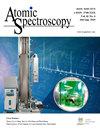In Situ Micro-XRD Methods For Identifying Glass And Minerals In Extraterrestrial Samples
IF 2.3
2区 化学
Q1 SPECTROSCOPY
引用次数: 1
Abstract
: Glass or amorphous state materials are vital components of lunar regolith and have attracted considerable attention. The analytical data on the texture and structure of glassy and crystallized materials can be used to reconstruct the geological history of the Moon. However, it is often challenging to distinguish glass from crystals based on morphology and elemental composition, especially in complex extraterrestrial samples that have been subjected to significant impact and metamorphism. In this study, micro-X-ray diffraction (µXRD) techniques were used to identify crystalline minerals and glassy phases in lunar breccia samples extracted in the Chang'e-5 mission. The samples were processed using different operating methods to identify a technique that would minimize damage to their original appearance and structure and yield optimal results. The diffraction results, which possessed two-dimensional patterns were classified into dominant dispersion halos, concentric diffraction rings, independent diffraction spots, and coexisting rings and spots. The results correspond to four types of sample states, namely, the amorphous material, polycrystal, single crystal, and a mixture of polycrystals and single crystals. By identifying the crystallization state and phases of various samples in a non-destructive and intuitive manner, µXRD can facilitate in situ analysis of special samples generated during important geological events, thereby promoting the understanding of complex origins and evolution of extraterrestrial bodies.原位微x射线衍射法鉴别地外样品中的玻璃和矿物
玻璃或非晶态材料是月球风化层的重要组成部分,引起了相当大的关注。玻璃状和结晶状物质的质地和结构分析数据可用于重建月球的地质历史。然而,根据形态和元素组成来区分玻璃和晶体通常是具有挑战性的,特别是在复杂的地外样品中,这些样品受到了重大的影响和变质作用。本文采用微x射线衍射(µXRD)技术对嫦娥五号月球角砾岩样品中的晶体矿物和玻璃相进行了鉴定。使用不同的操作方法对样品进行处理,以确定一种技术,可以最大限度地减少对其原始外观和结构的损害,并产生最佳结果。具有二维图样的衍射结果可分为优势色散晕、同心衍射环、独立衍射斑和环斑共存。结果对应于四种类型的样品状态,即非晶材料、多晶、单晶以及多晶和单晶的混合物。通过非破坏性和直观的方式识别各种样品的结晶状态和物相,µXRD可以促进对重要地质事件中产生的特殊样品的原位分析,从而促进对地外天体复杂起源和演化的理解。
本文章由计算机程序翻译,如有差异,请以英文原文为准。
求助全文
约1分钟内获得全文
求助全文
来源期刊

Atomic Spectroscopy
物理-光谱学
CiteScore
5.30
自引率
14.70%
发文量
42
审稿时长
4.5 months
期刊介绍:
The ATOMIC SPECTROSCOPY is a peer-reviewed international journal started in 1962 by Dr. Walter Slavin and now is published by Atomic Spectroscopy Press Limited (ASPL). It is intended for the rapid publication of both original articles and review articles in the fields of AAS, AFS, ICP-OES, ICP-MS, GD-MS, TIMS, SIMS, AMS, LIBS, XRF and related techniques. Manuscripts dealing with (i) instrumentation & fundamentals, (ii) methodology development & applications, and (iii) standard reference materials (SRMs) development can be submitted for publication.
 求助内容:
求助内容: 应助结果提醒方式:
应助结果提醒方式:


